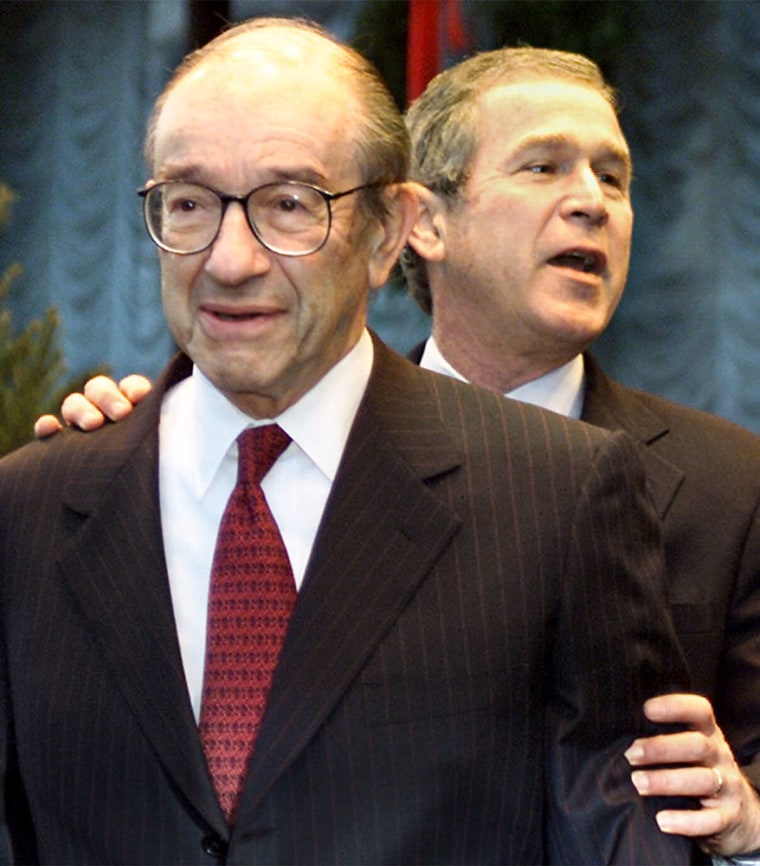Consumer prices surged 0.6 percent in May, the biggest increase in more than three years, the Labor Department said Tuesday, mostly due to the soaring costs of commodities like gasoline and milk, which are expected to moderate.
Financial markets heaved a sigh of relief as the underlying “core” rate of inflation rose only 0.2 percent, suggesting to traders that the Federal Reserve will raise its benchmark interest rate a quarter-percentage point June 30, and not the half-point some had feared.
Fed Chairman Alan Greenspan supported that view in testimony before a Senate panel considering his nomination for another term in office, reiterating that rate hikes are “very likely to be measured over the quarters ahead.”
“Our general view is that inflationary pressures are not likely to be a serious concern in the period ahead,” Greenspan said. Last week, Greenspan and other central bankers had chilled markets by cautioning that Fed policy-makers would raise rates more aggressively if needed to tamp down rising inflation.
Stock prices rallied after the inflation figures were released, with the Dow Jones industrial closing 46 points higher. Bond market interest rates fell sharply as traders wrote off any chance of a half-point rate hike this month.
“There was a big change in expectations. That accounts for the rally in stocks and bonds,” said Tony Crescenzi, chief bond market strategist for Miller Tabak & Co. “The market was fearful the report would be worse — and seal the deal on the half-point scenario for June or August or both.”
The widely watched Consumer Price Index was up 3.1 percent over year-earlier levels, while the core CPI, which excludes food and energy prices, was up 1.7 percent. That is still a sharp increase from the 1.1 percent core rate seen as recently as January, but represents a slight drop from the 1.8 percent rate reported a month ago.
“The data was pretty close to what economists were forecasting,” said Ethan Harris, chief U.S. economist at Lehman Bros. “But if you talk to traders and other people, they were all looking for an ugly number. … The sentiment going into the report was very negative. So I think there is a sense of relief that the number was as expected.”
Gasoline prices rose 8.1 percent last month and were up 30 percent over year-earlier levels, and milk prices soared 14.5 percent, the biggest increase since World War II. But there is some reason for optimism in recent reports that gasoline prices fell in early June, a time when seasonal demand normally causes them to rise.
Because higher energy prices tend to depress economic activity, the Fed generally discounts them when considering the long-term inflation concerns. Other price measures show inflation accelerating but still below the Fed’s presumed target zone, economists said.
And while consumers are bracing for higher inflation, any concerns apparently are being more than offset by improving conditions in the job market. Consumer sentiment has surged unexpectedly this month, according to market sources who have seen preliminary figures published by the the University of Michigan.
Consumer sentiment is rising even though earnings are not keeping up with inflation, at least for blue-collar and non-supervisory workers. Inflation-adjusted wages fell 0.4 percent in May from April, according to the Bureau of Labor Statistics. Such workers made an average of $531.76 last week, according to the BLS report.
That report offered fuel for Democratic presidential candidate John Kerry, who has renewed his attacks on President Bush’s handling of the economy this week after a weeklong suspension to observe a mourning period for former President Reagan. Kerry has opened up his biggest lead of the campaign so far over Bush in at least one public opinion poll, even though the economy at last has bounced back to create nearly 1 million jobs over the past three months.
At campaign events in Ohio and New Jersey Tuesday, Kerry promoted his plan to ease the burden on middle-class workers facing higher prices for health care, education and energy. “I’m running for President because I want an economy that strengthens and expands the middle class, not one that squeezes it,” Kerry said, according to excerpts from his prepared remarks.”
Despite the weak wage growth, analysts said there is nothing in the latest crop of data that will force the Fed to act aggressively when the policy-making Federal Open Market Committee meets in two weeks.
“All told, we believe the data this morning give the Fed little in the way of a smoking gun to do anything more than raise the funds rate 25 basis points at the June 29-30 FOMC meeting,” Merrill Lynch senior economist Jose Rasco said in a report.
The FOMC is almost universally expected to raise the benchmark overnight federal funds rate from a 48-year low of 1 percent when it concludes the scheduled two-day meeting.
It will be the first rate hike since May 2000 and raises the question of how far and how fast the central bank will go. Already long-term mortgage rates have jumped nearly a full percentage point from their recent March lows, sapping homebuilder sentiment.
Builder confidence fell 2 points in June to a reading of 67, although that was still ahead of the reading of 62 a year ago, when long-term mortgage rates fell to their lowest level in 50 years.
